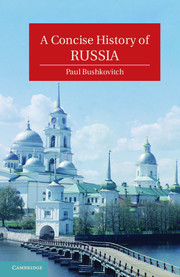Book contents
- Frontmatter
- Contents
- List of Figures
- Abbreviations
- Acknowledgments
- Prologue
- 1 Russia before Russia
- 2 Moscow, Novgorod, Lithuania, and the Mongols
- 3 The Emergence of Russia
- 4 Consolidation and Revolt
- 5 Peter the Great
- 6 Two Empresses
- 7 Catherine the Great
- 8 Russia in the Age of Revolution
- 9 The Pinnacle of Autocracy
- 10 Culture and Autocracy
- 11 The Era of the Great Reforms
- 12 From Serfdom to Nascent Capitalism
- 13 The Golden Age of Russian Culture
- 14 Russia as an Empire
- 15 Autocracy in Decline
- 16 War and Revolution
- 17 Compromise and Preparation
- 18 Revolutions in Russian Culture
- 19 Building Utopia
- 20 War
- 21 Growth, Consolidation, and Stagnation
- 22 Soviet Culture
- 23 The Cold War
- Epilogue
- Further Reading
- Index
2 - Moscow, Novgorod, Lithuania, and the Mongols
Published online by Cambridge University Press: 05 June 2012
- Frontmatter
- Contents
- List of Figures
- Abbreviations
- Acknowledgments
- Prologue
- 1 Russia before Russia
- 2 Moscow, Novgorod, Lithuania, and the Mongols
- 3 The Emergence of Russia
- 4 Consolidation and Revolt
- 5 Peter the Great
- 6 Two Empresses
- 7 Catherine the Great
- 8 Russia in the Age of Revolution
- 9 The Pinnacle of Autocracy
- 10 Culture and Autocracy
- 11 The Era of the Great Reforms
- 12 From Serfdom to Nascent Capitalism
- 13 The Golden Age of Russian Culture
- 14 Russia as an Empire
- 15 Autocracy in Decline
- 16 War and Revolution
- 17 Compromise and Preparation
- 18 Revolutions in Russian Culture
- 19 Building Utopia
- 20 War
- 21 Growth, Consolidation, and Stagnation
- 22 Soviet Culture
- 23 The Cold War
- Epilogue
- Further Reading
- Index
Summary
After the gradual disintegration of Kiev Rus, the regional powers that supplanted it began to grow apart. In these centuries the territories of Novgorod and the old northeast began to form a distinct language and culture that we can call Russian. Though the older term Rus persisted until replaced by Russia (Rossiia) in the fifteenth century, for this period we may begin to call the area Russia and the people Russian. In these centuries, Russia, like the other territories of Kiev Rus that would fall to Lithuania, experienced a cataclysm in the form of the Mongol invasion, one that shaped its history for the next three centuries.
The Mongol Empire was the last and largest of the nomadic empires formed on the Eurasian steppe. It was largely the work of Temuchin, a Mongolian chieftain who united the Mongolian tribes in 1206 and took the name of Genghis Khan. In his mind, the Eternal Blue Heaven had granted him rule over all people who lived in felt tents, and he was thus the legitimate ruler of all inner Asian nomads. The steppe was not enough. In 1211 Genghis Khan moved south over the Great Wall and overran northern China. His armies then swept west, and by his death in 1227, they had added all of Inner and Central Asia to their domains.
- Type
- Chapter
- Information
- A Concise History of Russia , pp. 19 - 36Publisher: Cambridge University PressPrint publication year: 2011

